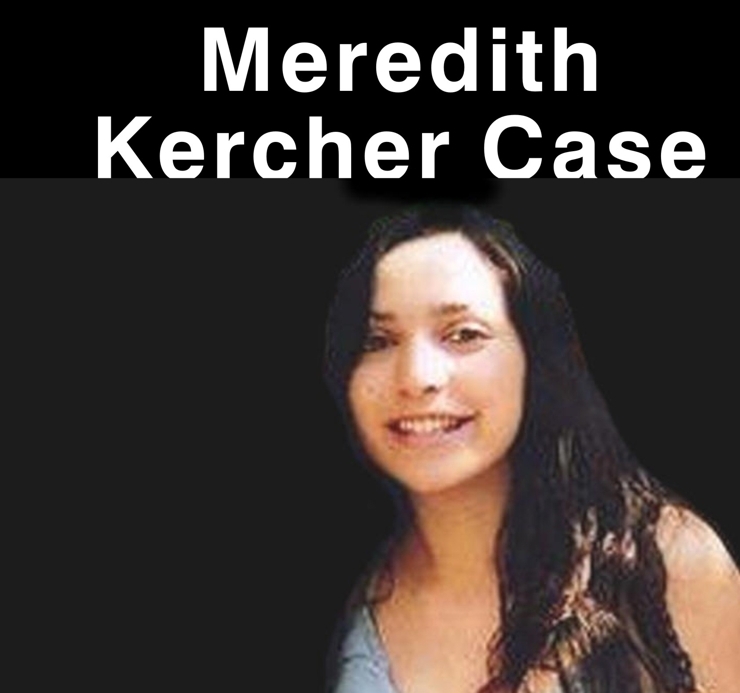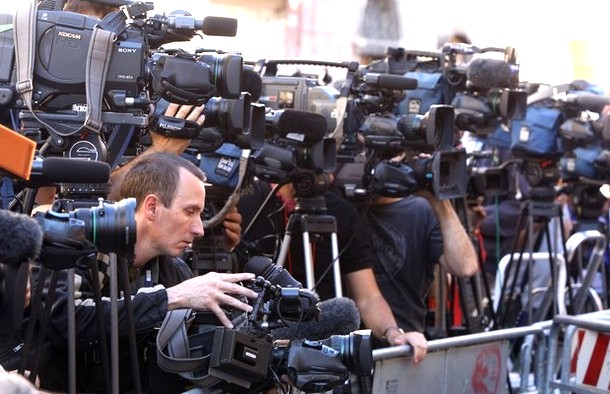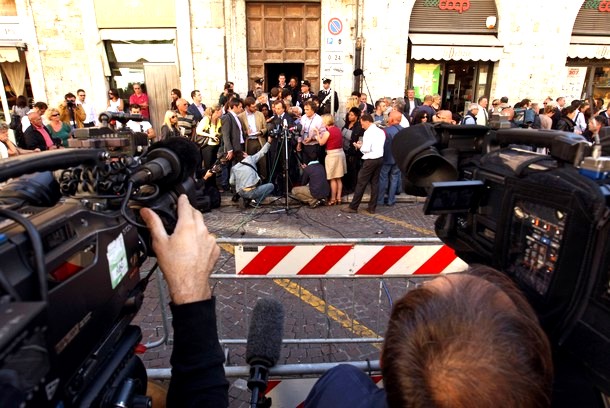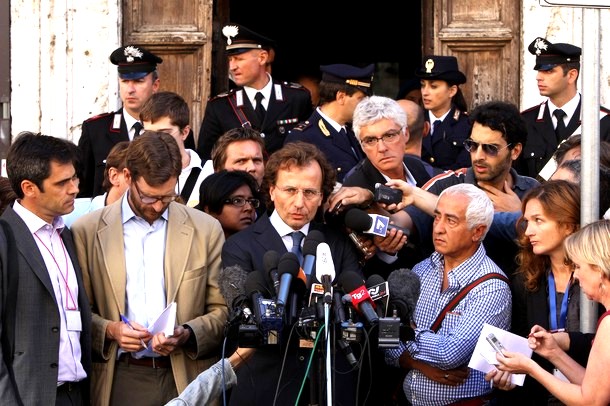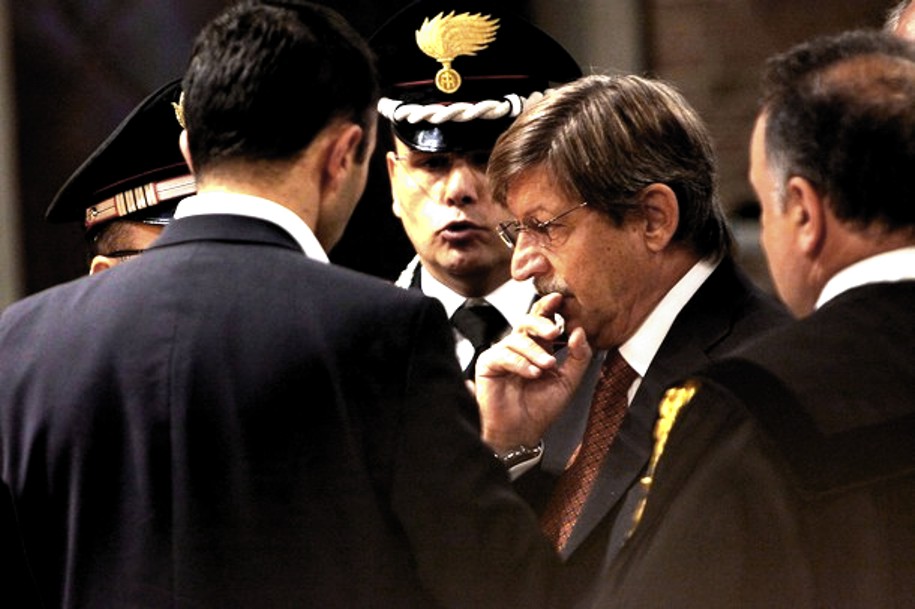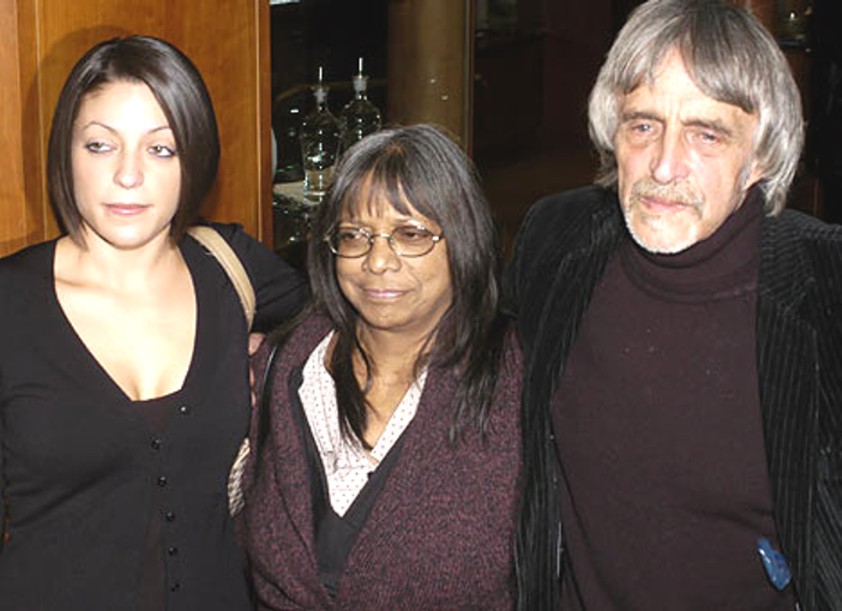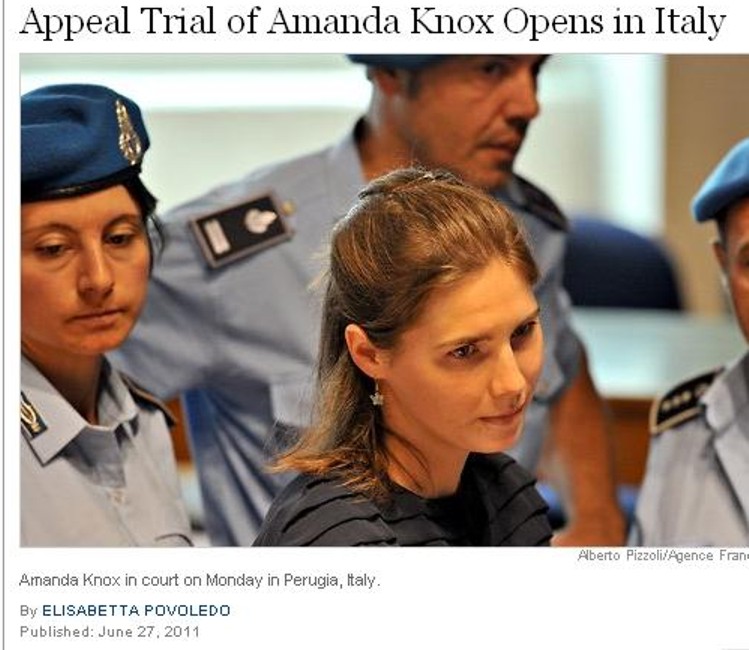
Category: Media developments
Wednesday, October 05, 2011
Nancy Grace’s “Miscarriage Of Justice” Observation Goes Viral, Google Says It’s On 38,000 Sites
Posted by Peter Quennell
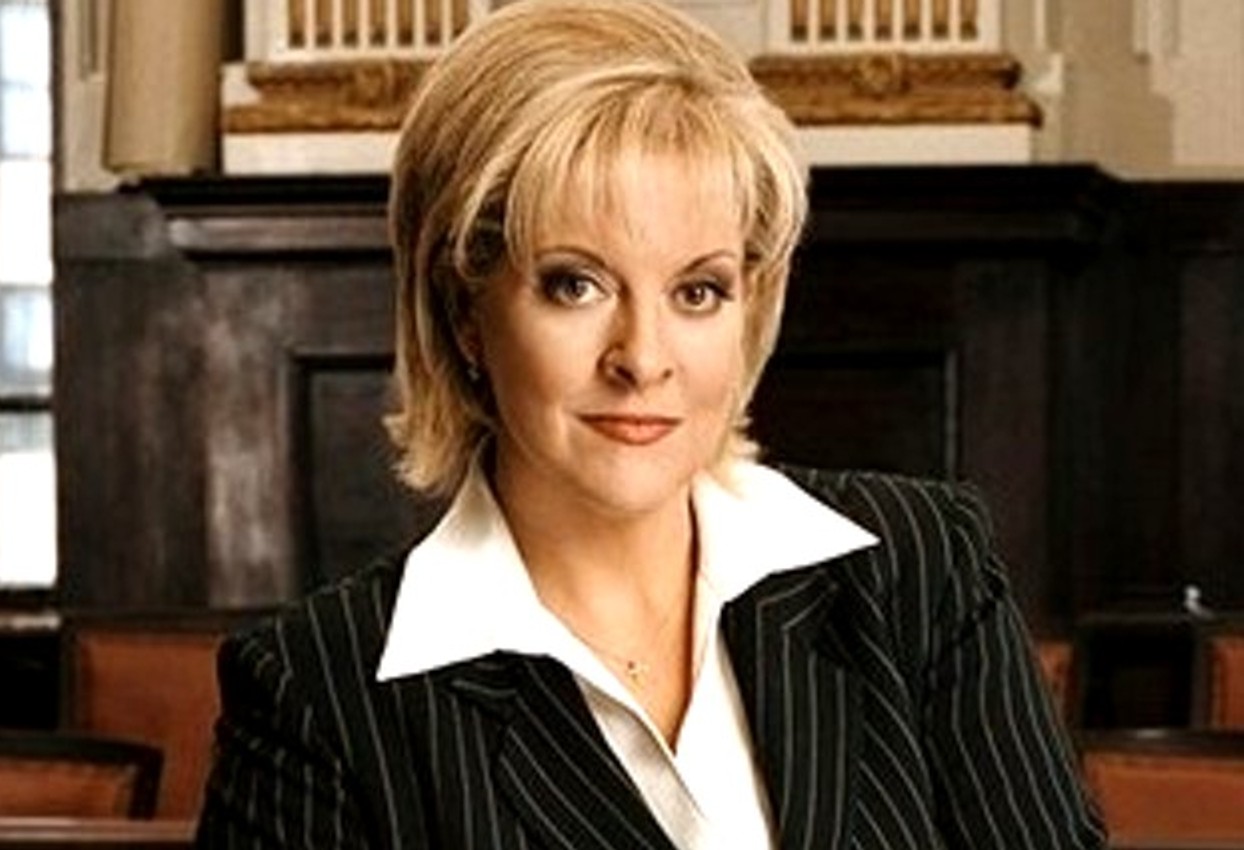
Amanda Knox will be lucky if CNN’s popular legal commentator Nancy Grace doesn’t get on her case the way she still is on Casey Anthony’s.
Nancy Grace says there is NO innnocent explanation for Knox’s second written confession placing her at the house (with Patrick Lumumba) and including observations that only someone who really was there could have known.
We have noticed that time and again commentators have come out batting for Knox, read the evidence, and then gone quiet. Nancy Grace’s CNN colleague Jane Velex-Mitchell had swallowed the Kool Aid at one point, but now she is ambivalent and careful.
Here is Huffington Post Media’s version of what Nancy Grace said last night.
Nancy Grace issued a typically blunt verdict on Amanda Knox during a Monday interview.
The outspoken HLN host and fierce ‘Dancing with the Stars’ competitor declared her true feelings about Knox when she spoke to Access Hollywood following her waltz performance Monday night.
“I was very disturbed, because I think it is a huge miscarriage of justice,” Grace said. “I believe that while Amanda Knox did not wield the knife herself, I think that she was there, with her boyfriend, and that he did the deed, and that she egged him on. That’s what I think happened.”
In Knox’s final plea, she told an Italian appeals court that she was not present the evening her British roommate Meredith Kercher was sexually assaulted and brutally murdered in their shared apartment. Grace said she did not think Knox is telling the truth. “I believe her original statement to the police - that she was there in the home when her roommate was murdered was true,” Grace told Access Hollywood.
Social networks like Twitter and Facebook exploded with celebratory messages on Monday as the judge proclaimed Knox’s innocence, allowing the study abroad student to finally return home to Seattle, Washington after four years in an Italian prison.
Grace was not one of those supporters, saying that while she would love to believe Knox innocent, “I just happen to know the facts.” Grace was even harsher when asked if her show would compete with other networks to get the first Knox interview.
“I’m not trying to get Amanda Knox’s first interview because”¦ my show does not pay for interviews…Second, I don’t think she’s going to tell the truth anyway, so what’s the point?” Grace responded.
THAT will get the noses of thousands of new followers firmly into the REAL evidence. Not all that made-up stuff. Other legal commentators may follow Nancy Grace’s lead, because she is the real pace-setter and power broker in that community.
The equally popular Fox News political and legal commentator Bill O’Reilly discussed the verdict on Monday night with Judge Andrew Napolitano, another prominent commentator. This is from the the summary on Bill O’Reilly’s website.
]Bill O’Reilly] concurred that Amanda Knox likely knows what happened on the night British student Meredith Kercher was murdered; therefore, we shouldn’t really be happy with this outcome since a terrible crime is unsolved.
Pity that Judge Napolitano claimed that Amanda Knox was interrogated as a suspect for 56 hours without an attorney. That did NOT happen. She had an attorney present at all times. Someone please correct him. .
Tuesday, October 04, 2011
Media Reaction Commences: What Is It About Amanda Knox…
Posted by Peter Quennell

Media can be a fickle friend. Big bucks may now be dictating a U-turn. One early indicator?
We should be happy for her, the innocent victim of this terrible miscarriage of justice.
Yet there is something disquieting about Amanda Knox, something that slightly chills the blood. Those piercing blue eyes, as cold as the steel of the knife that slit Meredith Kercher’s throat, have hardly flinched during her court appearances.
Not since Lindy-the dingo-did-it-Chamberlain was cleared of murdering her baby has a woman so divided public opinion.
Amanda’s prison diaries reveal an astonishing calmness and self-belief. While most 20-year-old girls falsely accused of a vile sex murder would be in pieces, she was planning her 21st birthday party, right down to the guest list.
There is hardly a mention of the brutal murder of her friend in the bedroom next to her. It’s all about Amanda.
Even The Independent’s Peter Popham is pouring cold water on the parade. Helping to find “the real killers” may be a way to help stem this tide.
Monday, October 03, 2011
Twentieth Appeal Session: The TV Media Assembled At Front Entrance Of The Court Today
Posted by Peter Quennell
Saturday, October 01, 2011
“Million Dollar Campaign” To Try To Influence The Jury Is Being Widely Reported To A Startled Italy
Posted by Peter Quennell

It looks like a perfect storm is flaring up in Italy for the hapless Knox PR campaign. Just about every media outlet in Italy seems to be running a variation of this report.
Next Monday will see delivered the verdict against the girl in prison since 2007 on charges of murder of her British roommate Meredith Kercher. The decision was confirmed today by a judge of the court in Perugia.
Meanwhile there transpires shocking news: The Amanda Knox clan has spent a million dollars to change her image and influence the jury. This is one of the allegations made by the prosecutor during the summations of the appeal of Amanda Knox.
“Have you ever seen a defendant who takes on a large public relations firm?” asked the prosecutor Giuliano Mignini, which the people on the benches behind the lawyers deny. “Behind her was a communication campaign for a million dollars.”
The much touted executive jet waiting at the airport to whisk her home gets considerable mention in a very negative way, as does the fact that a freed Knox stands to make many millions.
Also much mentioned is that a freed Amanda Knox might never come back to Italy for the final appeal before the Supreme Court of Cassation which is due next year. Cassation is the ONLY body in the Italian justice system that can finally declare whether Knox is guilty or innocent. The Hellman court, like the Massei court, can only in effect make recommendations.
Also reported is that Michelle Moore of the Knox entourage may well be charged for her bizarre verbal lunge at Mr Mignini during a break at court. The file on that case is being sent to Florence, where cases involving court officers in Perugia are handled, for a decision to be made.
And also reported is that Steve Moore, who seems to us to have the mother of all tin ears, is still ranting on about those clumsy Italians. Steve Moore so far as we know speaks no Italian and is now on his first trip to Italy in the context of this case. He has still not listed the evidence he claims he has reviewed (which of course is all in Italian) or released his real resume.
With the meme now increasingly hostile to the campaign, we’d be surprised if there is not more to come.
Friday, September 23, 2011
An Overview Of What The Italian Media Are Saying In Advance Of The Final Appeal Sessions
Posted by Peter Quennell
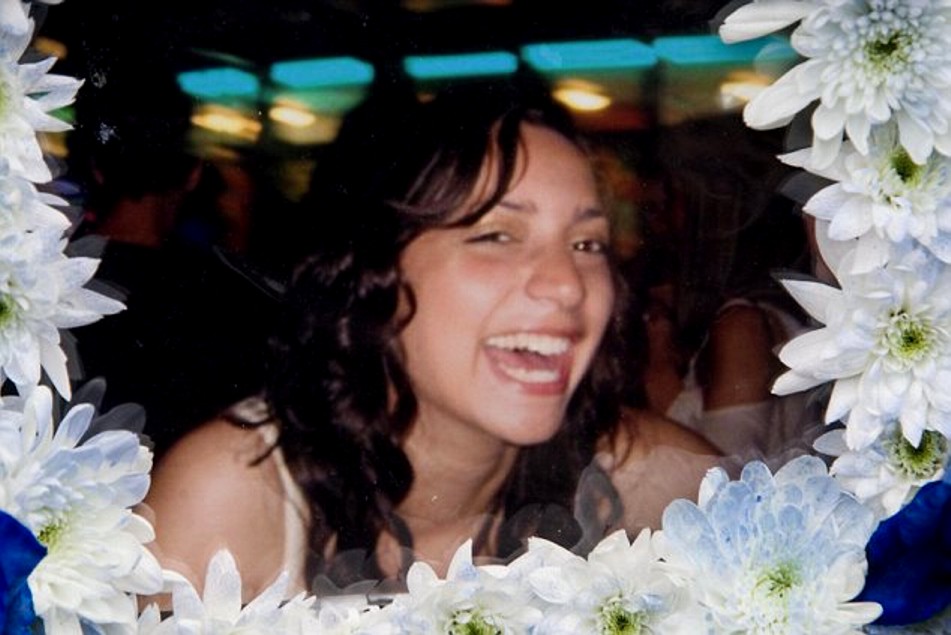
As usual, Meredith and her family and the prosecution are being given much more space than in the USA and UK.
Italian media and the Italian public are generally cognizant of the fact that no final verdict for this level of crime can be issued except by the Supreme Court. In effect what Judge Hellman’s court will issue is a provisional finding, and Sollecito and Knox may not know their final verdict and sentence for a year and a half.
That is, if the Supreme Court does not bounce the case back to the lower courts for reconsideration of some aspect as quite often happens - that happened in the case of defense witness Mario Alessi’s wife though her final sentence was not greatly affected.
In that event a final outcome could take even longer.
Libero News reports (as we of course knew) that the prosecution will be seeking a more severe sentence and looking to exclude the mitigating circumstances that Judge Massei allowed.
Il Secolo reports the same thing, with no quotes from the defense teams. Prosecutors Giancarlo Costagliola, Giuliano Mignini, and Manuela Comodi will all present parts of the prosecution argument. Ms Comodi will rebutt the independent experts’ report on some of the DNA.
Il Secolo also mentions that that the court has accepted that Guede has confirmed Knox’s and Sollecito’s presence at the house. Unclear where this comes from but usually it is impossible to be sure what was weighted heavily until the sentencing report comes out. No evidence is rejected in the Italian system; it is all carefully weighted instead. .
And many media sites are reporting in Italian a statement by Meredith’s mother. Here from Comments is a translation by our Italian poster ncountryside.
My daughter Meredith was killed while she was in the safest place: in her bedroom. Who killed her knew her well, but her confidence had been betrayed. For me it is inconceivable that should have happened.
My daughter was killed in her home. Not in a park, not in a street. Her body was not found in a garden.
I had talked with her the day before the murder. She was happy. She promised me that she would be back to celebrate my birthday. She had bought the chocolate that she wanted to give me.
During these four years I have never stopped thinking about her. And it is as if I always had her near me.
She loved Italy, She was fascinated by Perugia.
I do not care about the names of those convicted, I do not care whether they are called Rudy, Amanda and Raffaele. For me it’s just that my daughter was killed by someone who at first instance was found guilty and convicted.
In that trial there was much strong evidence, I am wondering what is happening to it now. They tell me that some may no longer be valid but they are two items, what of all the others? What has changed from the first trial?
I accepted the ruling of the Court of Assizes, and I accept what will be decided by the Court of Appeal and all the others will have to do like me without any distinction.
I want justice done for my daughter.
Wednesday, September 14, 2011
A New Book Explains The Unfruitful Emergence Of More And More Conspiracy Theories
Posted by Peter Quennell
Conspiracy theorists have dismally failed to come up with a plausible alternative theory of how Meredith died.
However, they do keep trying. So do the proponents of literally hundreds of other conspiracy theories, constituting vast amounts of effort probably better spent elsewhere - conspiracy theorists very rarely achieve very much, or do well economically, or rise to the top jobs.
The articles here and here look with skepticism on the 9/11 conspiracy theories which on the tenth anniversary of the twin towers coming down have been pushed hard by the various factions.
Now a new book “The Believing Brain” explains the mental makeup that disposes people to so eagerly believe the worst of our fellow man or our governments: One review in the Wall Street Journal..
In Mr. Shermer’s view, the brain is a belief engine, predisposed to see patterns where none exist and to attribute them to knowing agents rather than to chance””the better to make sense of the world. Then, having formed a belief, each of us tends to seek out evidence that confirms it, thus reinforcing the belief.
This is why, on the foundation of some tiny flaw in the evidence””the supposed lack of roof holes to admit poison-gas cans in one of the Auschwitz-Birkenau gas chambers for Holocaust deniers, the expectant faces on the grassy knoll for JFK plotters, the melting point of steel for 9/11 truthers””we go on to build a great edifice of mistaken conviction….
Mr. Shermer offers a handy guide for those who are confused. Conspiracy theories are usually bunk when they are too complex, require too many people to be involved, ratchet up from small events to grand effects, assign portentous meanings to innocuous events, express strong suspicion of either governments or companies, attribute too much power to individuals or generate no further evidence as time goes by.
The increasingly shrill posts appearing daily on the website Ground Report seem to mark pretty high against that list. Could the Evil Mignini have engineered even this?
Oops. Another conspiracy theory in play.
Saturday, September 10, 2011
Conspicuous By Their Absence Now: Legal Commentators For Sollecito And Knox
Posted by Peter Quennell
There is a marked sharp contrast now between how various reporters without legal backgrounds and various real lawyers are seeing the state of play in the appeal.
The post below shows how flavor-of-the-month reporters like Nick Pisa are still reporting happy talk from Knox and her entourage, while, within their professional constraints, we see more and more lawyers realisng Sollecito and Knox really are cooked.
Half a dozen of the main posters on TJMK who are lawyers (they identify themselves as such when they post) have explained how tough is the real case. Various Italian lawyers continue to offer us insights and tips from Perugia and Rome. And we continue to see maybe half a dozen lawyers a week getting in touch by email or signing up, a trend that shows no sign of fading out.
In contrast all of the lawyers and legal commentators who were once suggesting the process in Perugia had taken a wrong turn have gone quiet, and no new legal voices for Solllecito and Knox are speaking up. The CNN legal shows devote almost no air time to the appeal, and Geraldo Rivera, Dan Abrams, John Q Kelly, Lis Wiehl and others have wound down their commentaries to brief equivocations or nothing at all.
Ted Simon who is believed to be still on the Mellas-Knox payroll seems be operating only from very deep cover. Knox’s own lawyers pass on the (to us sad) happy talk from Capanne while themselves sounding very cautious and down.
And the former lawyer and political commentator Ann Coulter who does us the peculiar favor of including us in her definition of right wing is starkly declaring that the increasingly small number of increasingly shrill non-lawyers for Sollecito and Knox really should get a life.
By now, the only people who believe Knox and Sollecito are the usual criminal apologists and their friends in the American media.
Serial smearer and evidence incompetent Steve Moore as one of the usual criminal apologists?! That has to hurt.
Monday, July 18, 2011
Respected Journalist Carl Bernstein Criticizes “Murdochism” For Debasing News Reporting
Posted by Peter Quennell
Carl Bernstein was one of the two intrepid Washington Post reporters who helped to bring down President Nixon over the illegalities of Watergate.
He is being seen daily on American TV now and (as above) on British TV decrying the reporting methods and culture which are now being exposed in London, and the manufacture of false news and sensationalism which have left audiences falsely angered and concentrating on all the wrong things.
And which are now resulting in a large popular backlash, and the fleeing of advertisers from the Murdoch newspapers.
On the whole, the UK Murdoch media vehicles reported fairly on Meredith’s case (Sky News, London Times, London Sunday Times, The Sun) but the New York Post stirred things up (see here and here) as did especially Geraldo Rivera on his talk show on Fox TV News.
And the aggressive sensationalist culture did spread far and wide. The much milder competitor to the New York Post, the New York Daily News, has this to say::
The question now is whether the scandal will bring down the most successful propaganda fount in the world, Fox News, or if it will simply continue to sell factoids as “fair and balanced” fact.
This is much more serious than merely hurling mud at a target who has long helped Republicans by slinging loads of mud. The basic problem is, as Carl Bernstein points out in Newsweek, Murdoch became terribly influential with a simple way of doing things:
Just reduce every issue to a child’s level of perception with sensational headlines leading only to black and white, bad and good. In the practices of his mammoth News Corp., Murdoch always sent ethics and fact flying out the window in favor of profits. .
The New York Times has posted a good history of how and why Rupert Murdoch evolved his media culture in Troubles That Money Can’t Dispel here.
As of today, it looks like Rupert Murdoch and possibly his two sons and daughter may all have to stand down in face of anger from News Corps’ nine independent directors on its board of sixteen. News Corps stock value has been hemorrhaging half a billion a day for two weeks.
The directors may also pull the plug on more newspapers and maybe make News Corp exclusively an entertainment company - and get out of faux news.
Monday, June 27, 2011
Today’s New York Times Headline: Why Most US Main Media Should Be Disbelieved And Ignored
Posted by Peter Quennell
But (1) this is an appeal, not a trial, and (2) the first session was back in November 2010. It stands uncorrected still. But (as Fly By Night observes in a comment) this weird correction appears down below.
Tuesday, May 31, 2011
In Europe Human Rights Especially Privacy Trumping Web Defamers And Damaging Journalism
Posted by Peter Quennell
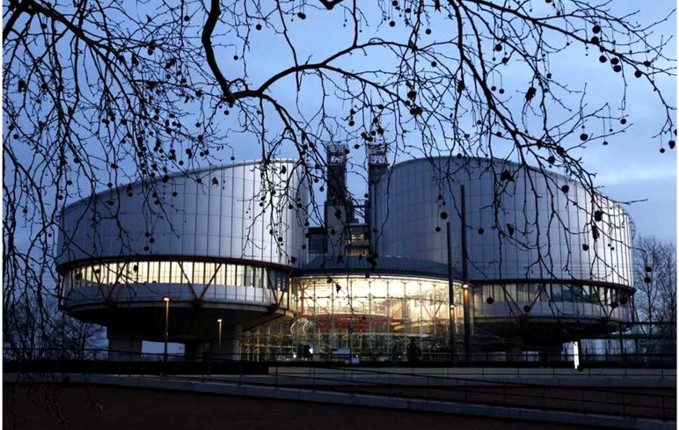
The legal lie of the land seems to be increasingly in favor of those in Italy and the UK and even the US being serially defamed by “Bruce Fisher” and others on the cynical pro-Knox bandwagon.
The European Community’s Parliament and the European Court of Human Rights (image above) are both situated in Strasbourg in north-east France. The ECHR was established in 1998 by the Council of Europe, not the EC, and it has 47 member governments including Russia.
It receives its basic guidance from the European Convention on Human Rights. Article 10 on freedom of expression and human rights reads as follows:
1. Everyone has the right to freedom of expression. This right shall include freedom to hold opinions and to receive and impart information and ideas without interference by public authority and regardless of frontiers. This article shall not prevent States from requiring the licensing of broadcasting, television or cinema enterprises.
2. The exercise of these freedoms, since it carries with it duties and responsibilities, may be subject to such formalities, conditions, restrictions or penalties as are prescribed by law and are necessary in a democratic society, in the interests of national security, territorial integrity or public safety, for the prevention of disorder or crime, for the protection of health or morals, for the protection of the reputation or rights of others, for preventing the disclosure of information received in confidence, or for maintaining the authority and impartiality of the judiciary.
Note the real strength of that second paragraph. While free speech is generally favored, it will not be protected if it is unfairly damaging to individuals or anarchic to the functions of courts and the governments.
With the pervasive spread of the internet, and the huge potential now for damage to be done globally, the ECHR generally mirrors national courts ruling in favor of those individuals who had been defamed and damaged by unfounded claims by journalists and internet posters.
Many member governments now have firmer human rights legislation either in place or in the pipeline, and the right to personal privacy and protection on matters that do not affect the public good is invariably a strong part of that new legislation.
Here is Julius Melnitzer of Canada’s National Post explaining, in the context of one case in which the ECHR did rule against a national court, that this is not the main trend being observed (emphasis added).
The European Court of Human Rights ruled on Tuesday that British reporters and journalists need not contact the subjects of potentially defamatory stories before publication to protect people’s privacy.
But the decision isn’t likely to quell the potential for litigation against individuals and businesses arising from online publication of statements that negatively impact reputations.
That’s partly because the law of defamation and the law of privacy are quietly blending, all to the advantage of victims, particularly celebrities, who have been defamed or have had their privacy invaded….
“There’s clearly an increasing overlap between the law of defamation and the law of privacy,” says Michael Smith, who practices defamation law at the Toronto office of Borden Ladner Gervais LLP. “Individual social media users should be concerned, but employers face even greater risk because each time an employee posts a negative comment online while at work, or from a work asset such as a laptop or smartphone, the employer is exposed to liability.”...
It’s not just negative comments, but unduly intrusive ones, that can attract liability. While the mere fact that something is true and not malicious may prove a defence to defamation, victims can base their case on an invasion of privacy so long as there is no public interest in reporting the subject matter of their claim.
It’s not that Canada has seen a host of such social media-related suits. “But Canadians spend more time online than any other nationality, which means it’s only a matter of time before we start seeing these types of cases,” Mr. Smith says. “People are thinking less about they’re writing, and they’re firing off knee-jerk reaction missives without a sober second thought.”
As well, high-profile cases like the one involving Mr. Mosley and the extensive publicity afforded rocker Courtney Love’s recent payment of US$430,000 to settle a suit over defamatory remarks she made on Twitter means that awareness of victims’ rights will grow.
“And that’s when we’re likely to see an influx of defamation cases related to social media,” Mr. Smith says. Many, of course, will be small cases, of the mom and pop variety. But the upside on liability is huge.
“As the courts have noted, defamation or breach of privacy on the Internet can amount to permanent, worldwide damage to reputation,” Mr. Smith says.
Smart move of Knox’s and Sollecito’s parents to be far more restrained now in their public comments these days, especially as all of them will face their own day in court. Perhaps those driving the Knox bandwagon should do likewise.
Maybe first stop inventing approximately 100% of their “facts” and scrub their internet postings clean.
